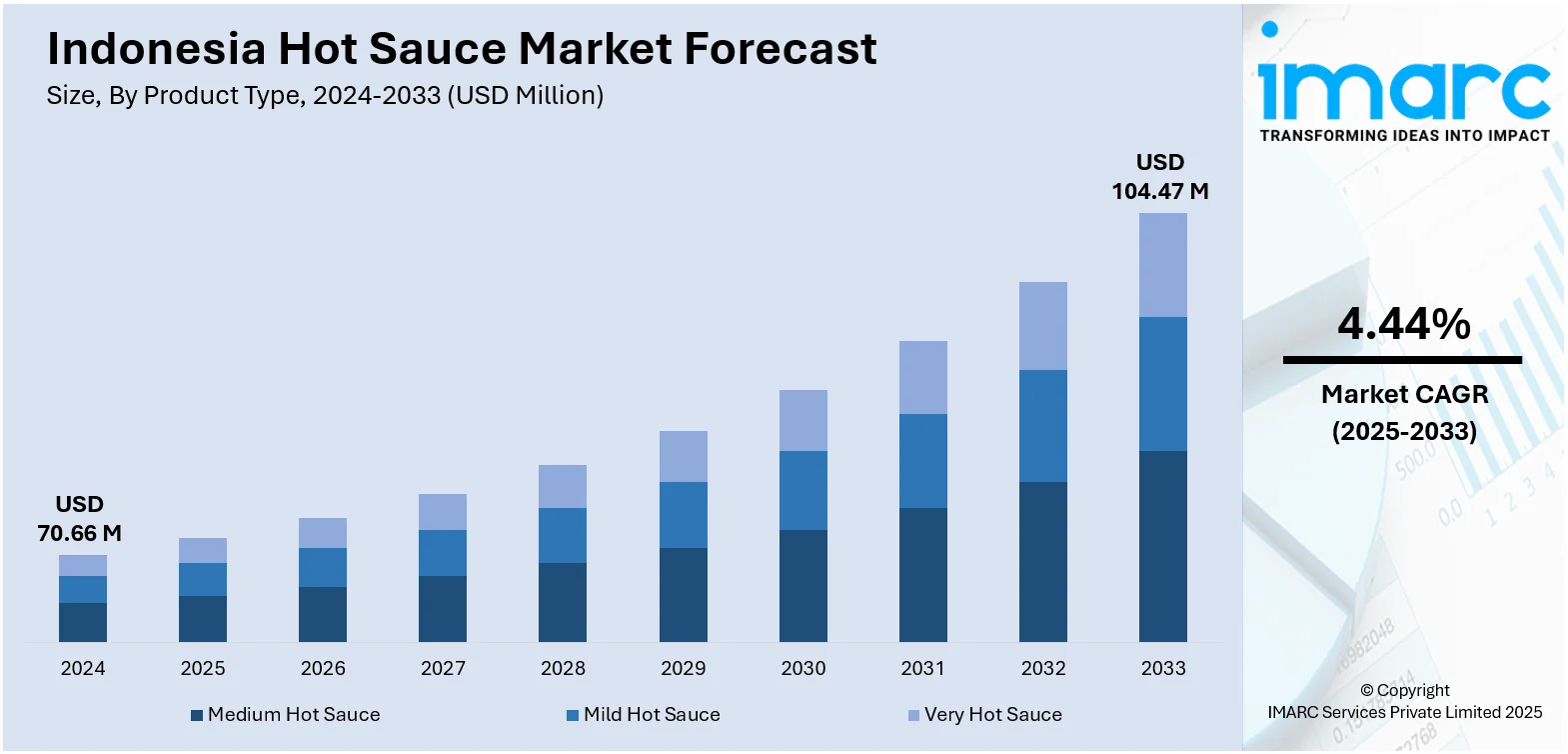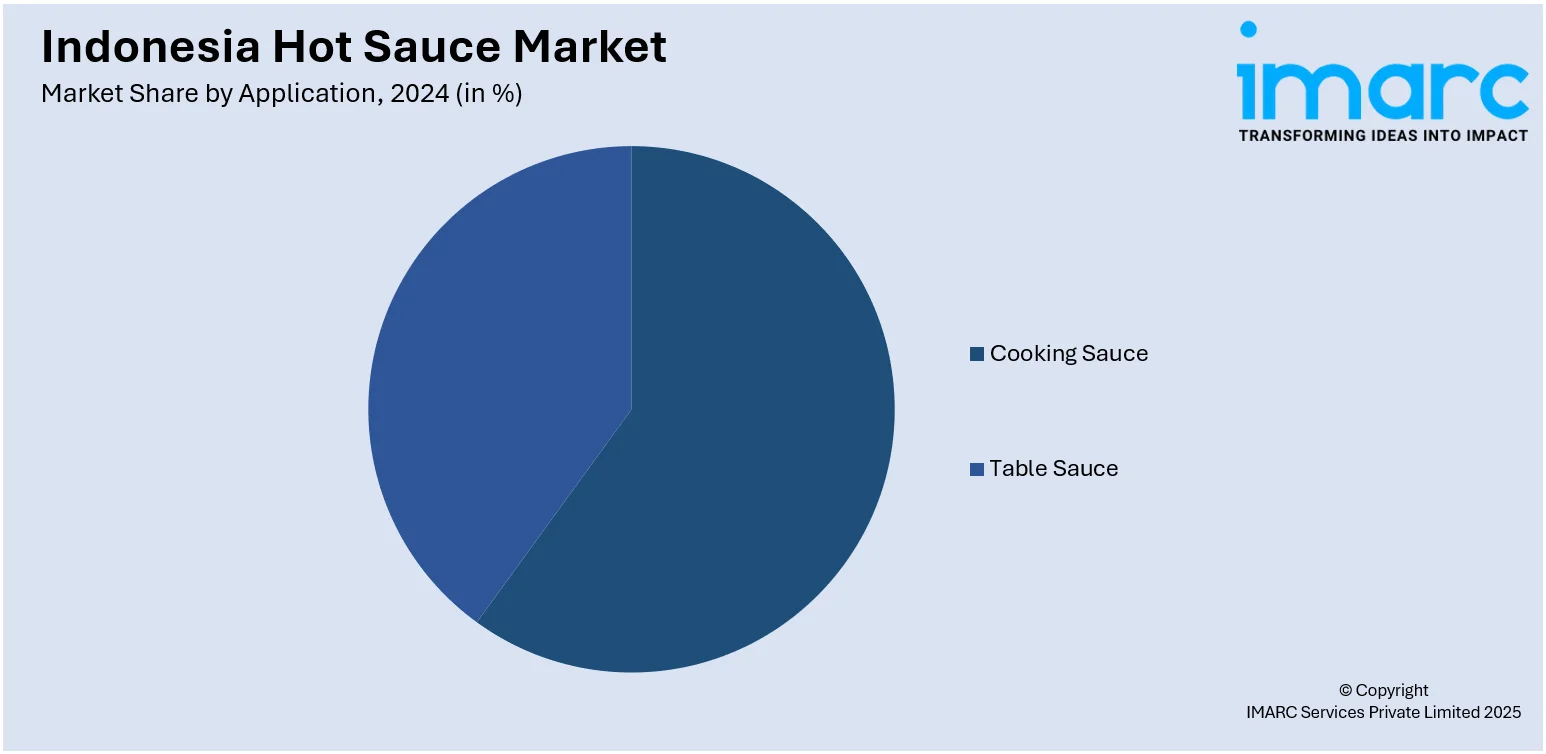
Indonesia Hot Sauce Market Size, Share, Trends and Forecast by Product Type, Application, Packaging, Distribution Channel, End Use, and Region, 2025-2033
Indonesia Hot Sauce Market Overview:
The Indonesia hot sauce market size reached USD 70.66 Million in 2024. Looking forward, IMARC Group expects the market to reach USD 104.47 Million by 2033, exhibiting a growth rate (CAGR) of 4.44% during 2025-2033. At present, health-conscious consumers in Indonesia are finding out more about the health benefits of spicy food. This, along with the rising preferences for interesting flavor profiles among the masses, is propelling the market growth. Moreover, the enlargement of e-commerce and retail channels is expanding the Indonesia hot sauce market share.
|
Report Attribute
|
Key Statistics
|
|---|---|
|
Base Year
|
2024
|
|
Forecast Years
|
2025-2033
|
|
Historical Years
|
2019-2024
|
| Market Size in 2024 | USD 70.66 Million |
| Market Forecast in 2033 | USD 104.47 Million |
| Market Growth Rate 2025-2033 | 4.44% |
Indonesia Hot Sauce Market Trends:
Increasing Consumer Demand for Hot Flavors
Indonesian consumers are increasingly turning towards spicy taste in foods, driving the demand for hot sauces. Given the fact that Indonesian food is naturally full of intense, spicy flavors, consumers are always looking to add variety and heat to their meals. Local culinary habits like sambal are deeply rooted in the culture, which creates a condition where spicy condiments hold great premium. Besides this, trends in food experimentation across the world and the increasing popularity of global cuisines are prompting people to try out different, spicy foods. This trend is driven by the expanding foodservice outlets as restaurants and fast-food centers keep introducing new items based on changing tastes for spicy condiments. This is, in turn, fueling the continued growth of the hot sauce industry, with both conventional and new hot sauce types being in higher demand throughout households and dining outlets.

To get more information on this market, Request Sample
Growth of the Retail and E-commerce Platforms
The continued growth of both retail and online channels in Indonesia is playing an important role in offering a favorable market outlook. New retail formats, including supermarkets and hypermarkets, are widely carrying a variety of hot sauce products, which are becoming more available to the growing urban consumer. Moreover, online marketplaces are becoming imperative in making the purchase of niche and foreign hot sauce brands more accessible, enabling consumers to readily access multiple products from the comfort of their homes. This aspect of convenience matters greatly in city areas where hectic lifestyles are urging shoppers to go online. Traders are also actively marketing hot sauce products through digital promotions and in-store visuals, raising awareness among consumers and influencing purchasing intent. This distribution channel expansion is effectively widening the market coverage, and hot sauce is becoming a household item in the majority of Indonesian homes. IMARC Group predicts that the Indonesia e-commerce market is projected to attain USD 760.8 Billion by 2033.
Increasing Trends of Health and Wellness
Health-conscious consumers in Indonesia are finding out more about the health benefits of spicy food, and this is creating demand for hot sauces. Ingredients used in hot sauces, like chili peppers, have capsaicin, which has been found to offer numerous health benefits like increased metabolism, enhanced digestion, and better cardiovascular health. As per NielsenIQ (NIQ), in 2025, almost half (46%) of the population indicates that they are taking proactive measures to enhance their health, such as engaging in physical activity, tracking health metrics, and making intentional dietary decisions. Consequently, consumer demand for products that are seen to be both tasty and healthy continues to grow. This demand is particularly strong among younger generations, who are more attracted to functional foods, which have health benefits. Manufacturers are also evolving to provide hot sauce products that contain clean, natural ingredients, tapping into the rising demand for food label transparency. By catering to the health-conscious trends, the industry is growing to meet a broader and more health-conscious customer base, strengthening the Indonesia hot sauce market growth.
Indonesia Hot Sauce Market Segmentation:
IMARC Group provides an analysis of the key trends in each segment of the market, along with forecasts at the country and regional levels for 2025-2033. Our report has categorized the market based on product type, application, packaging, distribution channel, and end use.
Product Type Insights:
- Medium Hot Sauce
- Mild Hot Sauce
- Very Hot Sauce
The report has provided a detailed breakup and analysis of the market based on the product type. This includes medium hot sauce, mild hot sauce, and very hot sauce.
Application Insights:

- Cooking Sauce
- Table Sauce
A detailed breakup and analysis of the market based on the application have also been provided in the report. This includes cooking sauce and table sauce.
Packaging Insights:
- Jars
- Bottles
- Others
A detailed breakup and analysis of the market based on the packaging have also been provided in the report. This includes jars, bottles, and others.
Distribution Channel Insights:
- Supermarkets and Hypermarkets
- Traditional Grocery Retailers
- Online Stores
- Others
A detailed breakup and analysis of the market based on the distribution channel have also been provided in the report. This includes supermarkets and hypermarkets, traditional grocery retailers, online stores, and others.
End Use Insights:
- Commercial
- Household
A detailed breakup and analysis of the market based on the end use have also been provided in the report. This includes commercial and household.
Regional Insights:
- Java
- Sumatra
- Kalimantan
- Sulawesi
- Others
The report has also provided a comprehensive analysis of all the major regional markets, which include Java, Sumatra, Kalimantan, Sulawesi, and others.
Competitive Landscape:
The market research report has also provided a comprehensive analysis of the competitive landscape. Competitive analysis such as market structure, key player positioning, top winning strategies, competitive dashboard, and company evaluation quadrant has been covered in the report. Also, detailed profiles of all major companies have been provided.
Indonesia Hot Sauce Market Report Coverage:
| Report Features | Details |
|---|---|
| Base Year of the Analysis | 2024 |
| Historical Period | 2019-2024 |
| Forecast Period | 2025-2033 |
| Units | Million USD |
| Scope of the Report |
Exploration of Historical Trends and Market Outlook, Industry Catalysts and Challenges, Segment-Wise Historical and Future Market Assessment:
|
| Product Types Covered | Medium Hot Sauce, Mild Hot Sauce, Very Hot Sauce |
| Applications Covered | Cooking Sauce, Table Sauce |
| Packagings Covered | Jars, Bottles, Others |
| Distribution Channels Covered | Supermarkets and Hypermarkets, Traditional Grocery Retailers, Online Stores, Others |
| End Uses Covered | Commercial, Household |
| Regions Covered | Java, Sumatra, Kalimantan, Sulawesi, Others |
| Customization Scope | 10% Free Customization |
| Post-Sale Analyst Support | 10-12 Weeks |
| Delivery Format | PDF and Excel through Email (We can also provide the editable version of the report in PPT/Word format on special request) |
Key Questions Answered in This Report:
- How has the Indonesia hot sauce market performed so far and how will it perform in the coming years?
- What is the breakup of the Indonesia hot sauce market on the basis of product type?
- What is the breakup of the Indonesia hot sauce market on the basis of application?
- What is the breakup of the Indonesia hot sauce market on the basis of packaging?
- What is the breakup of the Indonesia hot sauce market on the basis of distribution channel?
- What is the breakup of the Indonesia hot sauce market on the basis of end use?
- What is the breakup of the Indonesia hot sauce market on the basis of region?
- What are the various stages in the value chain of the Indonesia hot sauce market?
- What are the key driving factors and challenges in the Indonesia hot sauce market?
- What is the structure of the Indonesia hot sauce market and who are the key players?
- What is the degree of competition in the Indonesia hot sauce market?
Key Benefits for Stakeholders:
- IMARC’s industry report offers a comprehensive quantitative analysis of various market segments, historical and current market trends, market forecasts, and dynamics of the Indonesia hot sauce market from 2019-2033.
- The research report provides the latest information on the market drivers, challenges, and opportunities in the Indonesia hot sauce market.
- Porter's five forces analysis assist stakeholders in assessing the impact of new entrants, competitive rivalry, supplier power, buyer power, and the threat of substitution. It helps stakeholders to analyze the level of competition within the Indonesia hot sauce industry and its attractiveness.
- Competitive landscape allows stakeholders to understand their competitive environment and provides an insight into the current positions of key players in the market.
Need more help?
- Speak to our experienced analysts for insights on the current market scenarios.
- Include additional segments and countries to customize the report as per your requirement.
- Gain an unparalleled competitive advantage in your domain by understanding how to utilize the report and positively impacting your operations and revenue.
- For further assistance, please connect with our analysts.
 Request Customization
Request Customization
 Speak to an Analyst
Speak to an Analyst
 Request Brochure
Request Brochure
 Inquire Before Buying
Inquire Before Buying




.webp)




.webp)












